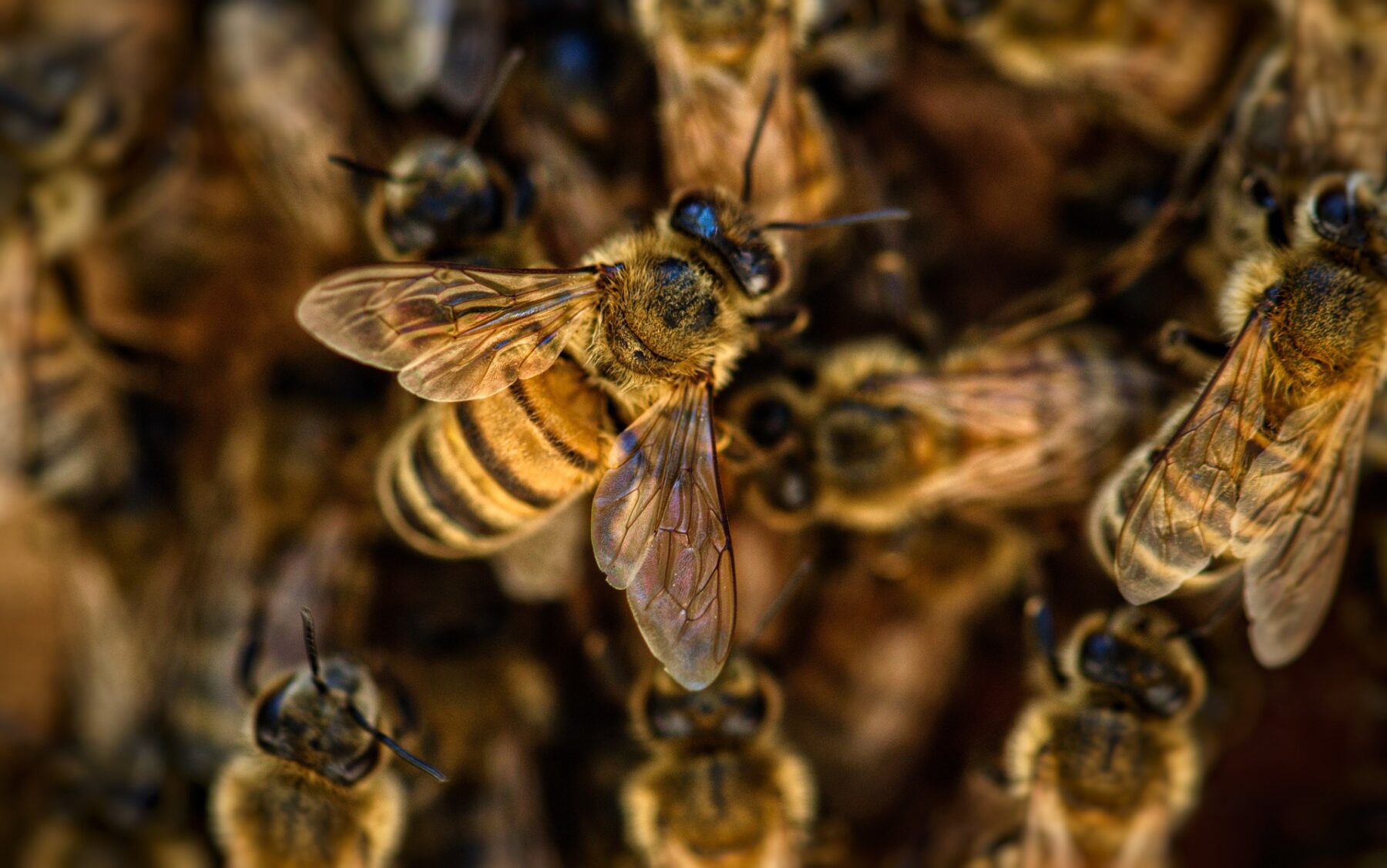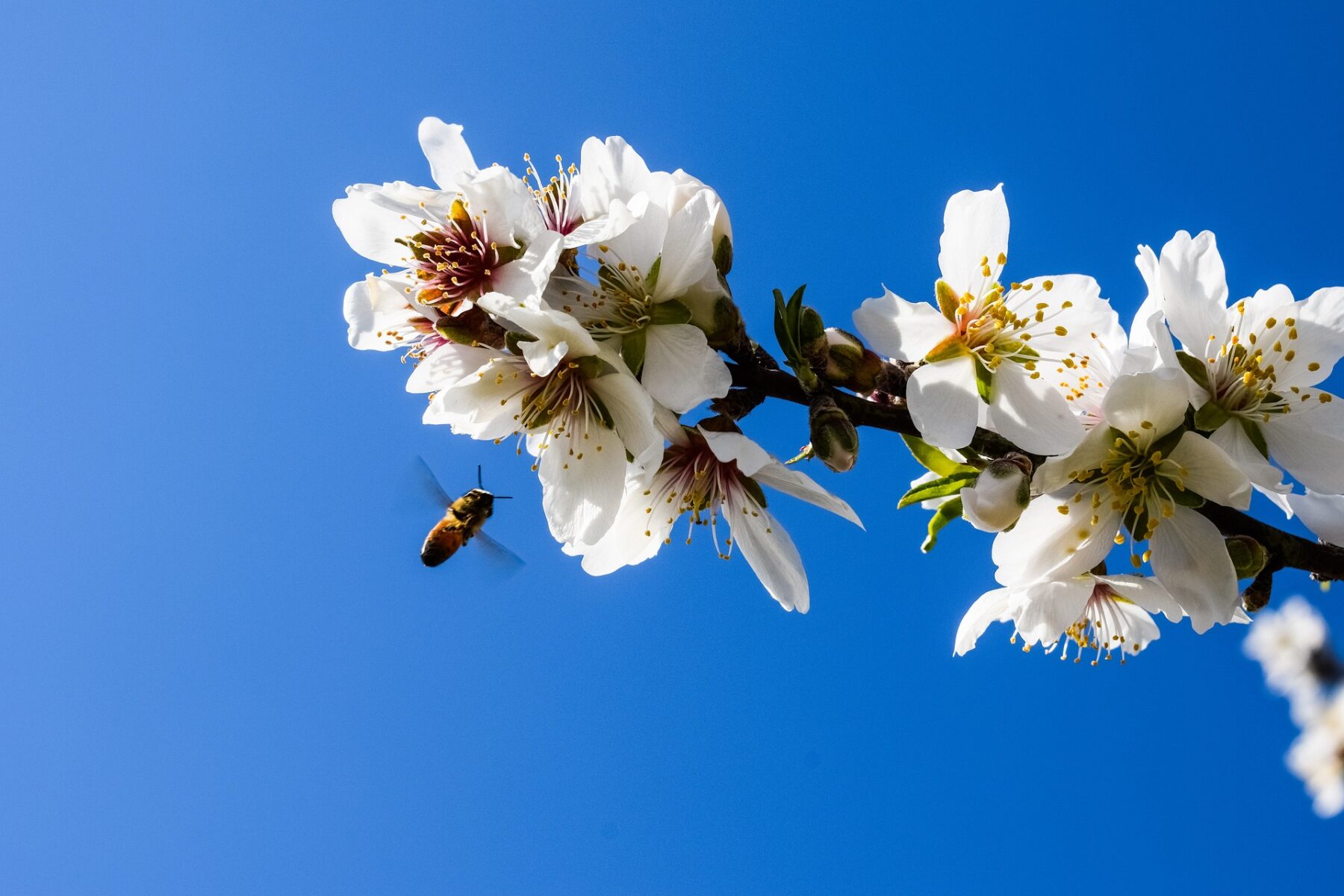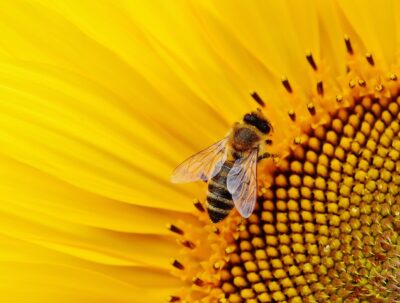There is a lot of talk in the animal protection world about sentience — the ability of animals to experience both physical and emotional feelings, such as pain, pleasure, distress, and joy. Anyone who has spent time with a dog or a cat, or a cow or a chicken, knows with absolute certainty that these animals are sentient, and governments around the world are starting to ratify in law the sentience of all vertebrates, as well as some invertebrates. But what about bees? Are they also sentient and if so, how does this change how we see them and, crucially, how we treat them?
All the Bees
There are 20,000 bee species on Earth within seven distinct families:
- Apidae includes bumble bees and honey bees
- Megachilidae are solitary bees and live on all continents except Antarctica
- Halictidae are ground-nesting bees
- Andrenidae are solitary ground-nesting bees
- Colletidae are known as ‘plasterer bees’ as they are able to waterproof their nests
- Melittidae is a small family of ground-nesting bees, most common in dry parts of Africa
- Stenotritidae is a very small family of bees, found only in Australia
A Bee’s Brain
Whatever their species, a bee’s brain is obviously tiny, about the size of a poppy seed. And, being so small, our pro-human bias jumped to the conclusion that there could not have been much activity going on inside. We were wrong, as we so often are when we allow our own human-centric prejudices to dictate how we see others.
Stephen Buchmann from the University of Arizona has studied bees for over 40 years. In his book What a Bee Knows; Exploring the Thoughts, Memories and Personalities of Bees, he demonstrates that bees have complex feelings, behaviors, and psychology. Buchmann argues that bees have sophisticated emotions that resemble optimism, frustration, playfulness, and fear. He cites experiments showing that bees recognize different human faces, learn simple tool use, and process long-term memories while sleeping. It is even possible that they dream.
He writes: “Bees are self-aware, they’re sentient… They solve problems and can think.” In fact, bees are known to be able to understand the concept of zero and can even add and subtract numbers. 1
Studying Bees
Professor Lars Chittka from Queen Mary University of London has also been studying bees for about 40 years and authored the book The Mind of a Bee. Sixteen years ago, he created an experiment to see whether bees could learn to avoid predators, an experiment that left the bees with something that resembled PTSD. Chittka’s experiments also discerned that bees respond to a release of feel-good natural chemicals in their brains, and that when exposed to a stressful situation, the release of these chemicals decreased. Just like humans.
From his work with bees, Chittka concludes that bees have emotions, can plan and imagine things, and can recognize themselves as unique entities distinct from other bees. He concludes: bees are sentient. Because of what he discovered, Chittka no longer runs any experiments that could cause trauma in bees, instead focusing only on “ethically defensible” experiments. Sadly, this is not the case for other scientists, especially those who study the effects of farming and agricultural chemicals on bees.

Honey Bees Are Farmed Animals
Most of us think of bees as wild creatures, happily buzzing between flowers looking for pollen and nectar. And many of them are wild. But with the global loss of habitats — 97 percent of wildflower-rich grasslands in the UK have been lost since the 1930s, for example — wild bee numbers have dropped and we need bees to pollinate crops. Instead of rectifying the damage done and supporting wild bee populations, there emerged a brand new trade in factory-farmed bees.
Why Are Honey Bees Farmed?
Most people know that bees are farmed so we can take their honey. This is the food that bees make to help the hive survive the winter. The sugar water that is given to them in lieu of the honey does not contain the essential nutrients and properties bees need to stay optimally healthy and it is believed that this contributes to the mass deaths of bees and the collapse of honey bee colonies.
What is less known is that honey bees are also farmed for their ability to pollinate. Three-quarters of all crops farmed globally require pollinators, including bees. When we farmed in accordance with local ecosystems, wild pollinators were plentiful and helped produce food for local populations. But today, vast swathes of land are doused in chemicals and all wild plants are killed off. There are few wild insects left in these hostile environments.
To fill the gap caused by reckless chemical use and poor farming practices, bee farming has sprung up, and it has become big business. Billions of bees are bred, rented out, and transported thousands of miles to where mono crops in an otherwise almost-sterile landscape need to be pollinated. Too often, the bees don’t survive; they are wiped out by exposure to pesticides, parasites, and other diseases, as well as the loss of natural habitats. “It’s like sending the bees to war,” says Nate Donley, of the Center for Biological Diversity. “Many don’t come back.”
Sadly, farmed bees are not the only victims of this trade. Researchers at Cambridge University found that the rise in purpose-bred bees also has negative consequences for their wild cousins through resource competition and the spread of disease. Given the sentience of bees, all of this means we have two distinct problems to consider: how we treat wild bees and how we treat farmed bees.

California’s Almonds
Farmed bees are used to pollinate many crops including apples, squash, melons, cranberries, broccoli, and almonds. And it’s that last crop, grown largely in California, that draws much of the focus around honey bee labor and death.
California grows 80 percent of the world’s almonds. To service the state’s vast farms, a huge trade in honey bee farming has sprung up. More than two million colonies, containing about 30 billion bees — or 70 percent of the commercial colonies in the US — are trucked to the farms each year. Not only do almond trees flower at a time of year when bees would normally be dormant, but those who are roused to do the job of pollinating are also exposed to a barrage of dangerous agrochemicals that ultimately poison the bees to death.
Entomologists have been warning about the dangers to bees of insecticides since 1936 and yet as the food system intensifies, the onslaught only gets worse. As Oliver Milman writes in his excellent book The Insect Crisis: The Fall of the Tiny Empires that Run the World, the industry’s “arsenal of deadly weapons” is killing bees in their billions.
Neonicotinoids
One of the most infamous types of agricultural insecticides is a group called neonicotinoids, known as neonics. These are “systemic pesticides” which means they don’t just remain on the leaves of the crops onto which they are sprayed, they are taken up by the plant and transported to every part: root, stems, pollen, and nectar. These dangerously potent chemicals affect the central nervous system of bees and other insects, causing eventual paralysis and death.
In 2008, there was a global mass die-off in honey bees which was eventually traced in part to a neonicotinoid. The maker of this chemical, Bayer, paid compensation but admitted no liability. Ten years later in Brazil, 500 million bees died; they were riddled with fipronil, an insecticide banned by the EU.
Today, almost every corn seed and cotton boll in the United States, and around half of all soybeans, are treated with neonics. Neonics typically cover 61 million hectares of US cropland, which is equivalent to the size of Texas. 1
Neonics are the modern iteration of DDT, the chemical first exposed by Rachel Carson in her powerfully important book Silent Spring, except that, as Oliver Milman writes, neonics are thought to be 7,000 times more toxic to honey bees than DDT. So dangerous are they that the EU has technically banned their use. However, while these dangerous chemicals cannot be used within the EU, according to a recent report by Unearthed, 10,000 tonnes are still being exported to poorer countries each year.
While the cause of colony collapse and mass bee deaths has primarily been attributed to pesticides, Steve Buchmann and other scientists believe that there is another element to it. They believe that the psychological stress caused by the reckless practices of industrialized agriculture is also a significant factor in the deaths of bees. Says Buchmann: “We are blasting bees with huge amounts of agrichemicals and destroying their natural foraging habitats. Once people accept that bees are sentient and can suffer, I think attitudes will change.”
We hope so.
Should Vegans Eat Almonds?
Given the mass exploitation and deaths of bees in the California groves, this is a choice that each of us must make, but this is a bigger problem than one state’s almond crop. All over the world, we have seen the same loss of habitats, and farmed bees are trucked to areas where crops need pollinating. Some are small-scale operations, with the beehives being transported relatively short distances, and the bees are generally brought home safely. Bees in other parts of the world, however, are sent knowingly to their deaths.
We have a food system that is so industrial — and so broken — that we as individuals have no way of knowing the full impacts on bees and insects, and all the animals who rely on them, of our own food choices. That said, there are some things we can do to help bees.
- We can choose to boycott the worst of the industries, and California’s almond crop is probably up there at the top.
- We can, if we can afford to, buy organic foods, which are grown with minimal chemical input and which protect bees and other insects. If we see the extra cost of this as a donation to an important environmental cause rather than a tax on doing the right thing, we may feel better about that added expense.
- We can join an organic veg box scheme if there is one near us; this often works out cheaper than buying organic produce from a store.
- We can join or start a local veg-growing community initiative, which can be hugely rewarding. This both prevents farmed bee exploitation and supports wild bees.
- If we have a garden or yard, we can grow a little of our own veg. It may not feed our families for a year but every time we eat foods that have not been doused in chemicals we support our own health as well as the health of bees, other insects, birds, and mammals.
- We can plant wildflowers wherever possible to support local bees and other insects.
- We can avoid using any chemicals in our gardens and yards.
- We can put up bee hotels to help wild bees in our area.
The Bigger Picture
The change from small-scale farms working in harmony with the natural world to mass industrialization has been swift. In the 1970s, Buchmann recalls that California’s almond industry was much smaller and that the groves were full of flowering wild plants. “The ground used to be buzzing with bees,” he says. “Now the almonds fall on bare ground or plastic sheeting and are vacuumed up by big harvesting units.”
Such industrialization has swept across the entire food system, bringing with it a wide range of devastating consequences, such as cutting down forests, driving wild animals to extinction, driving up climate change, polluting rivers and oceans, slaughtering billions of sentient beings every year, incubating deadly diseases that have pandemic potential, and helping bacterial superbugs to emerge through the reckless use of antibiotics. Amongst this carnage, the bees are just one victim; but all other animals, including humans, fall victim to this system.

Intelligent, Sentient, Exploited
There is no doubt among those who study bees that these animals are not only sentient but highly complex. And both Chittka and Buchmann believe other insects could be sentient and experience a range of emotions, too. This has huge implications for our current farming system as well as the current drive to farm insects both for human consumption and to be fed to other farmed animals.
It’s clear we need a revolution in how farms and the global food system operate. This is not something we as individuals have a whole lot of control over but we can recognize the many serious problems with the current system and understand that at its core, the food industry is largely run for the benefit of shareholders and wealth generation, not feeding a population with wholesome, nourishing, environmentally positive foods.
For now, what we can do is to make the most ethical food choices available to us, lobby our politicians to better protect the natural world, and make space for insects in our own lives – by creating and maintaining habitats that are suitable for them, and by speaking up for them wherever ignorance denies their importance, intelligence, and sentience.
Further reading on bees:
- ‘Bees Are Sentient’ by Annette McGivney
- The Insect Crisis: The Fall of the Tiny Empires that Run the World by Oliver Milman
- The Mind of a Bee by Lars Chittka
- What a Bee Knows; Exploring the Thoughts, Memories and Personalities of Bees by Stephen Buchmann
- The Bees, a novel by Laline Paull
1. The Insect Crisis: The Fall of the Tiny Empires that Run the World, Oliver Milman



